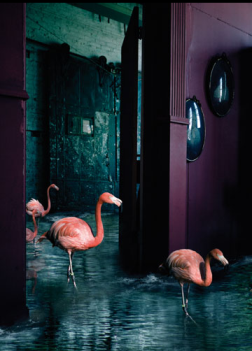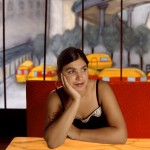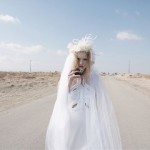Biennials – the rules of the game Since the first Biennial in 1991, I have invited my guest curators to think in terms of a key word. The word remains the same for three successive editions and is always a common word with topical connections and a fairly vague semantic range, a word capable both of artistic and societal interpretations. The first word, in 1991, was History. Then in 1997 it was Global, followed by Temporality in 2003 and, from 2009 to 2013, Transmission. When I submitted the word Transmission to Gunnar B. Kvaran, he responded in literal fashion with the word Narrative. The term is no more a subject than it is a title. It is merely the starting point for a dialogue upon which we are constructing three platforms. In the first place an exhibition – however the works are combined and in whatever venue, whatever is chosen and whatever is left out, it is still all about designing an exhibition. Second, Veduta – the laboratory of visual creation and experiment, in which artists in residence, the collection of the Lyon Musée d’Art Contemporain, works from the exhibition, and amateurs of all ages and social backgrounds combine to construct a new visual relationship with the world. And third, Résonance – a vast, polyphonic mass of creativity in which artists’ collectives, young galleries, neo-institutions, or just people taking risks with form, pay homage to the irrational in a sort of counterpoint to the exhibition, in the plural, and in the most valid of tenses, the present – the only tense that is independent of time. Narrative For Gunnar B. Kvaran to place narrative side by side with transmission is to state the obvious about what happens (“Reality is what happens”, as someone said). Gunnar B. Kvaran’s response to the neo-modernism that covers our walls with a patina of soft nostalgia is to place a new emphasis on form, which is a totally new form of thought. And the form of that thought is probably what is most eloquent about it. A story can be as good as you like but what makes it stand out in the end is the relevance of its form. The form creates the meaning by forming the narrative. The Little Prince said, “Tell me a story”. The poet drew it. by Thierry Raspail, Artistic director of the Biennale de Lyon The Biennale de Lyon 2013 Novelists and screenwriters always hope they have an interesting story. These days, politicians too and advertisers are all on the look-out for a good story that can be used to influence voters and consumers. Not only are there “countless forms of narrative in the world”, as Roland Barthes would have it, but now they are everywhere and an integral part of our daily life. For the Biennale de Lyon 2013, I have invited artists from all over the world who work in the narrative field and use art to experiment with the modalities and mechanisms of storytelling. The exhibition gives pride of place to the ingenuity and inventiveness of contemporary artists in undoing mainstream narrative codes and off-the-peg plotting devices in order to tell new stories differently. The art of these artist-storytellers comes in many and varied forms and uses a wealth of Press release 3 April 2013 Artistic director Thierry Raspail Guest Curator Gunnar B. Kvaran Professional preview 10 – 11 September 2013 from 12 September 2013 to 05 January 2014 biennaledelyon.com 1 2th Biennale de Lyon meanwhile… suddenly, and then 1 /2 2 /2 different registers, materials and techniques. So the exhibition naturally includes sculptures, paintings, fixed images, animated images, arrangements of text, arrangements of sounds and of objects in space, as well as performances. It highlights the way (or rather ‘ways’) in which young artists of today – according to whether they work in Europe, Asia, Latin America, Africa or North America – are imagining the narratives of tomorrow: narratives that do without the suspense and excitement of globalised fiction as practised in Hollywood, on television, or in the best-sellers of world literature. Theirs are totally new narratives that defamiliarise us with the world and restore the deep-rooted strangeness and complexity that classic storytelling devices have always sought to iron out or to stifle. These are art narratives that enable us to see and understand the world in a new light and more intelligibly. The young artists invited include Ed Atkins and Helen Marten from Britain, Czech artist Vaclav Magid, Americans Trisha Baga, Ian Cheng, Petra Cortright, Nate Lowman and Ryan Trecartin; Zhang Ding from China and Thiago Martins de Melo from Brasil, as well as French artists Neïl Beloufa and Lili Reynaud-Dewar. by Gunnar B. Kvaran, Guest curator of the Biennale de Lyon 2013 media pictures library Connect on www.biennaledelyon.com, press page, and ask for your accreditation to access to the pictures library. Biennials – the rules of the game Since the first Biennial in 1991, I have invited my guest curators to think in terms of a key word. The word remains the same for three successive editions and is always a common word with topical connections and a fairly vague semantic range, a word capable both of artistic and societal interpretations. The first word, in 1991, was History. Then in 1997 it was Global, followed by Temporality in 2003 and, from 2009 to 2013, Transmission. When I submitted the word Transmission to Gunnar B. Kvaran, he responded in literal fashion with the word Narrative. The term is no more a subject than it is a title. It is merely the starting point for a dialogue upon which we are constructing three platforms. In the first place an exhibition – however the works are combined and in whatever venue, whatever is chosen and whatever is left out, it is still all about designing an exhibition. Second, Veduta – the laboratory of visual creation and experiment, in which artists in residence, the collection of the Lyon Musée d’Art Contemporain, works from the exhibition, and amateurs of all ages and social backgrounds combine to construct a new visual relationship with the world. And third, Résonance – a vast, polyphonic mass of creativity in which artists’ collectives, young galleries, neo-institutions, or just people taking risks with form, pay homage to the irrational in a sort of counterpoint to the exhibition, in the plural, and in the most valid of tenses, the present – the only tense that is independent of time.Narrative For Gunnar B. Kvaran to place narrative side by side with transmission is to state the obvious about what happens (“Reality is what happens”, as someone said). Gunnar B. Kvaran’s response to the neo-modernism that covers our walls with a patina of soft nostalgia is to place a new emphasis on form, which is a totally new form of thought. And the form of that thought is probably what is most eloquent about it. A story can be as good as you like but what makes it stand out in the end is the relevance of its form. The form creates the meaning by forming the narrative. The Little Prince said, “Tell me a story”. The poet drew it.by Thierry Raspail, Artistic director of the Biennale de LyonThe Biennale de Lyon 2013 Novelists and screenwriters always hope they have an interesting story. These days, politicians too and advertisers are all on the look-out for a good story that can be used to influence voters and consumers. Not only are there “countless forms of narrative in the world”, as Roland Barthes would have it, but now they are everywhere and an integral part of our daily life. For the Biennale de Lyon 2013, I have invited artists from all over the world who work in the narrative field and use art to experiment with the modalities and mechanisms of storytelling. The exhibition gives pride of place to the ingenuity and inventiveness of contemporary artists in undoing mainstream narrative codes and off-the-peg plotting devices in order to tell new stories differently. The art of these artist-storytellers comes in many and varied forms and uses a wealth of Press release 3 April 2013Artistic director Thierry RaspailGuest Curator Gunnar B. KvaranProfessional preview 10 – 11 September 2013from 12 September 2013 to 05 January 2014 biennaledelyon.com1 2th Biennale de Lyon meanwhile… suddenly, and then1 /22 /2different registers, materials and techniques. So the exhibition naturally includes sculptures, paintings, fixed images, animated images, arrangements of text, arrangements of sounds and of objects in space, as well as performances. It highlights the way (or rather ‘ways’) in which young artists of today – according to whether they work in Europe, Asia, Latin America, Africa or North America – are imagining the narratives of tomorrow: narratives that do without the suspense and excitement of globalised fiction as practised in Hollywood, on television, or in the best-sellers of world literature. Theirs are totally new narratives that defamiliarise us with the world and restore the deep-rooted strangeness and complexity that classic storytelling devices have always sought to iron out or to stifle. These are art narratives that enable us to see and understand the world in a new light and more intelligibly. The young artists invited include Ed Atkins and Helen Marten from Britain, Czech artist Vaclav Magid, Americans Trisha Baga, Ian Cheng, Petra Cortright, Nate Lowman and Ryan Trecartin; Zhang Ding from China and Thiago Martins de Melo from Brasil, as well as French artists Neïl Beloufa and Lili Reynaud-Dewar.by Gunnar B. Kvaran, Guest curator of the Biennale de Lyon 2013 media pictures library Connect on www.biennaledelyon.com, press page, and ask for your accreditation to access to the pictures library.
:: ::
CONFERENZA STAMPA GIOVEDÌ 30 MAGGIO alle 9:30 Hotel Metropole, Venezia (in riva degli Schiavoni)
Info e Link:
Inaugurazione: 12 Settembre 2013 (Lione – Francia)
Quando: dal 12 Settembre al 5 Gennaio 2013
web: http://www.biennaledelyon.com





SCHEDE